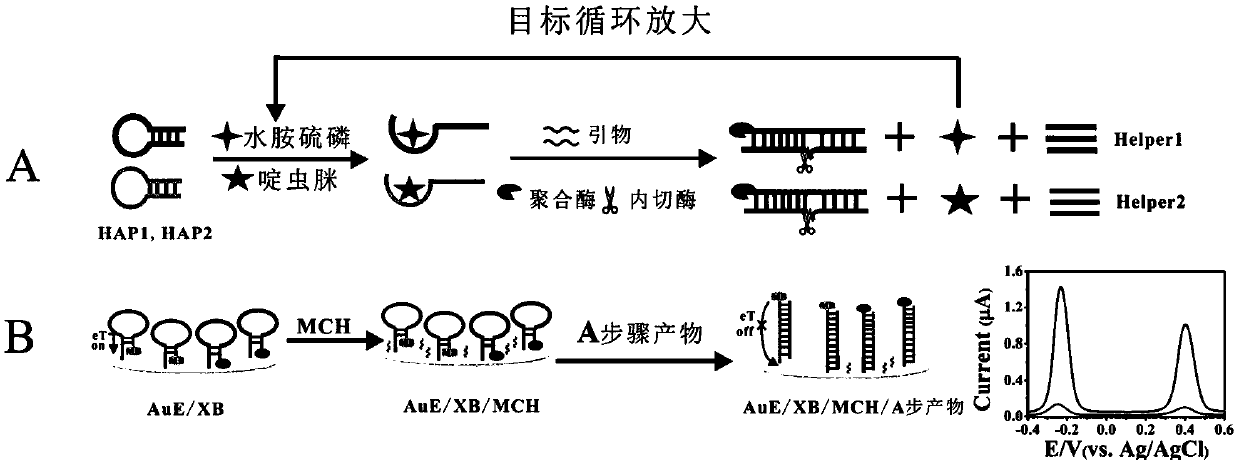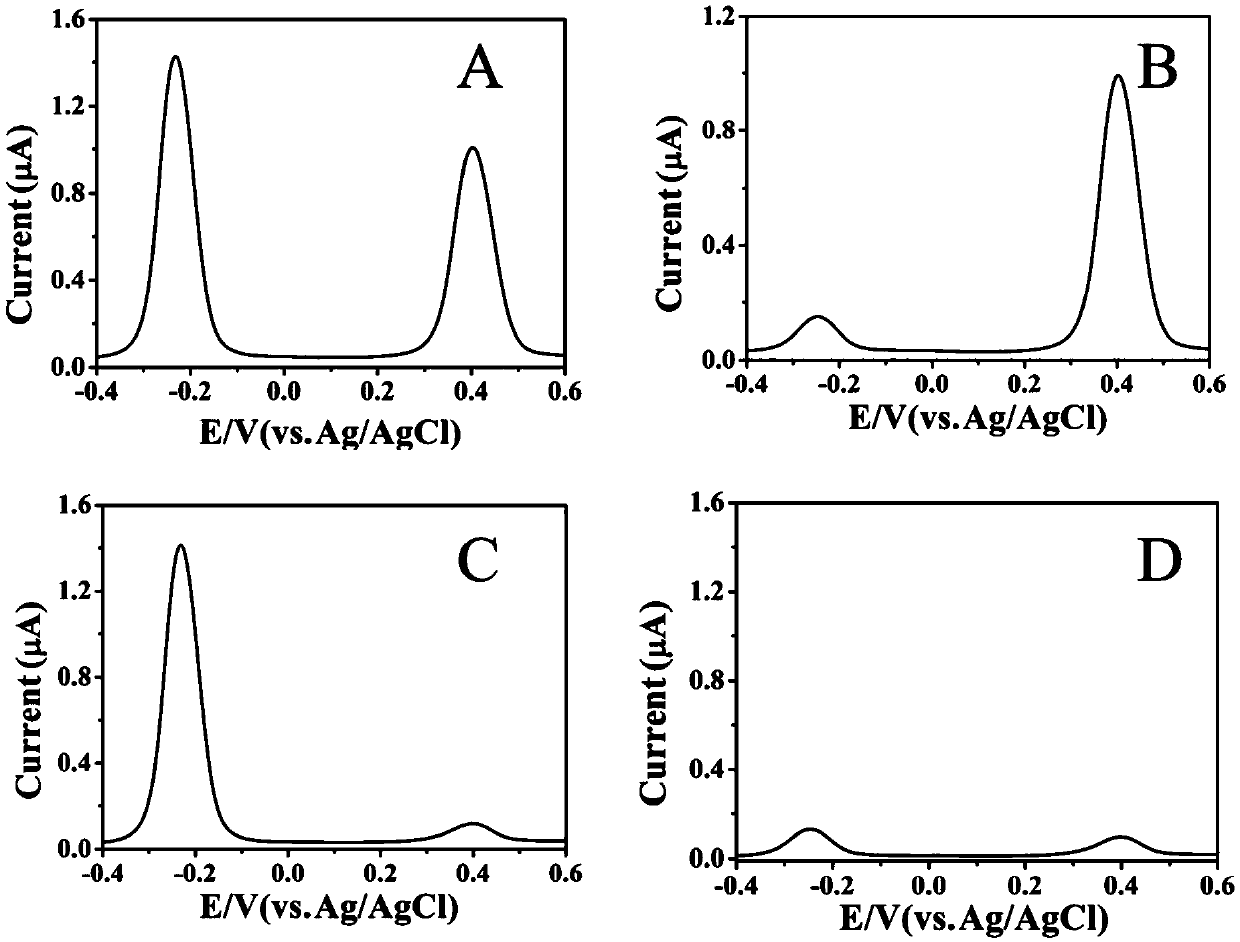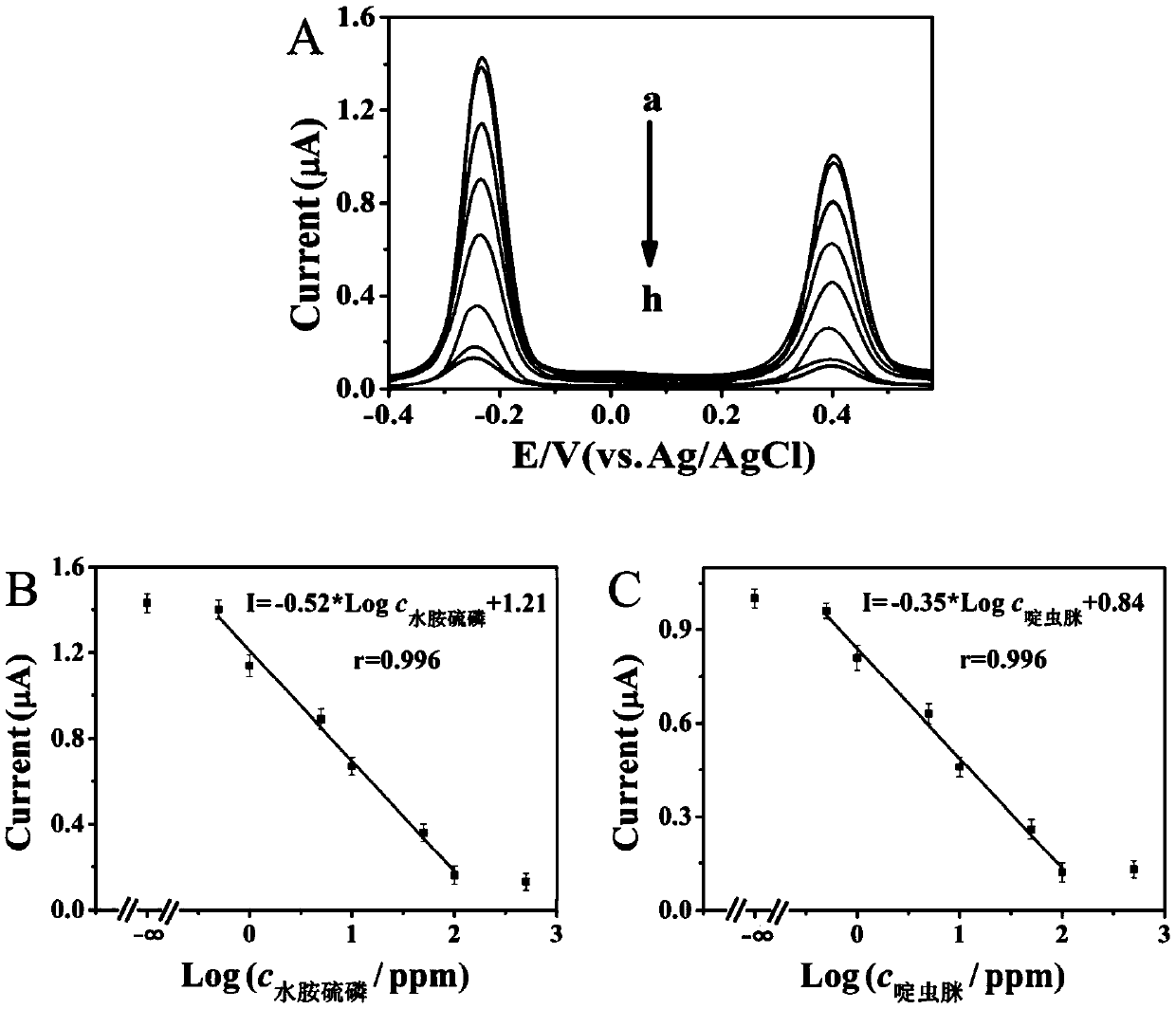Electrochemical sensor and method system for simultaneous detection of isocarbophos and acetamiprid
A technology of ammonium phosphine and acetamiprid, which is applied in the field of sensors and can solve the problems of complicated instrument operation and inability to achieve high throughput and the like
- Summary
- Abstract
- Description
- Claims
- Application Information
AI Technical Summary
Problems solved by technology
Method used
Image
Examples
Embodiment 1
[0072] a. The gold electrode was first polished in an alumina slurry with a particle size of 0.3 μm and an alumina slurry with a particle size of 0.05 μm until it became a mirror surface, and the electrode was immersed in 20 mL of H with a volume ratio of 3:1. 2 SO 4 and H 2 O 2 In the mixed solution, incubate for 20min and wash thoroughly with ultrapure water;
[0073] b. Add a total of 6 μL of XB solution (10 μM XB1: 2 μL and 10 μM XB2: 4 μL) dropwise to the electrode surface treated in step a, incubate at room temperature for 2 h, the beacon probe XB converts sulfhydryl groups through Au-S bonds The chain is fixed to the electrode surface.
[0074] c. Use MCH to block unspecific binding sites, specifically: drop 6 μL of 1 mM MCH solution onto the electrode surface, incubate for 30 min, and wash with PBS.
[0075] d, carry out homogeneous reaction, the main steps are:
[0076] 1. Add 2μL of 100nM HAP1, 2μL of 100nM HAP2 and 20μL of 1× Phi29 DNA polymerase buffer solutio...
Embodiment 2
[0084] a. The gold electrode is first polished in an alumina slurry with a particle size of 0.3 μm and an alumina slurry with a particle size of 0.05 μm until it becomes a mirror surface, and the electrode is immersed in 20 mL of H with a volume ratio of 3:1. 2 SO 4 and H 2 O 2 The mixture was incubated for 20 min and washed thoroughly with ultrapure water;
[0085] b. Add a total of 6 μL of XB solution (10 μM XB1: 2 μL and 10 μM XB2: 4 μL) dropwise to the electrode surface treated in step a, incubate at room temperature for 2 h, the beacon probe XB converts sulfhydryl groups through Au-S bonds The chain is fixed to the electrode surface.
[0086] c. Modify MCH to block unspecific binding sites.
[0087]d, the main steps in the homogeneous reaction:
[0088] 1. Add 2μL of 100nM HAP1, 2μL of 100nM HAP2, and 20μL of 1× Phi29 DNA polymerase buffer solution to the centrifuge tube, add excess ammonium phosphine (500ppb), and incubate at 37°C for 30min;
[0089] 2. Continue to...
Embodiment 3
[0095] a. The gold electrode is first polished in an alumina slurry with a particle size of 0.3 μm and an alumina slurry with a particle size of 0.05 μm until it becomes a mirror surface, and the electrode is immersed in 20 mL of H with a volume ratio of 3:1. 2 SO 4 and H 2 O 2 In the mixed solution, incubate for 20min and wash thoroughly with ultrapure water;
[0096] b. Add a total of 6 μL of XB solution (10 μM XB1: 2 μL and 10 μM XB2: 4 μL) dropwise to the electrode surface treated in step a, incubate at room temperature for 2 h, the beacon probe XB converts sulfhydryl groups through Au-S bonds The chain is fixed to the electrode surface.
[0097] c. Modify MCH to block unspecific binding sites.
[0098] d, the main steps in the homogeneous reaction:
[0099] 1. Add 2μL of 100nM HAP1, 2μL of 100nM HAP2 and 20μL of 1× Phi29 DNA polymerase buffer solution to the centrifuge tube, add excess acetamiprid (500ppb), and incubate at 37°C for 30min;
[0100] 2. Continue to add...
PUM
 Login to View More
Login to View More Abstract
Description
Claims
Application Information
 Login to View More
Login to View More - R&D
- Intellectual Property
- Life Sciences
- Materials
- Tech Scout
- Unparalleled Data Quality
- Higher Quality Content
- 60% Fewer Hallucinations
Browse by: Latest US Patents, China's latest patents, Technical Efficacy Thesaurus, Application Domain, Technology Topic, Popular Technical Reports.
© 2025 PatSnap. All rights reserved.Legal|Privacy policy|Modern Slavery Act Transparency Statement|Sitemap|About US| Contact US: help@patsnap.com



